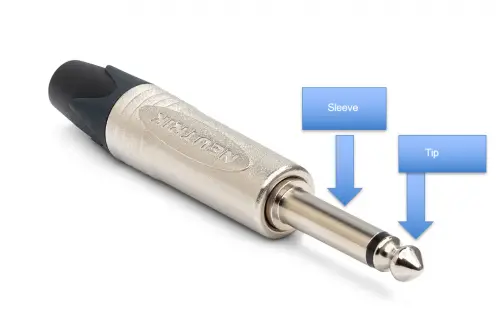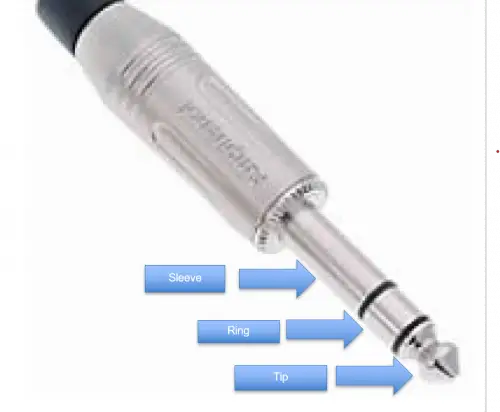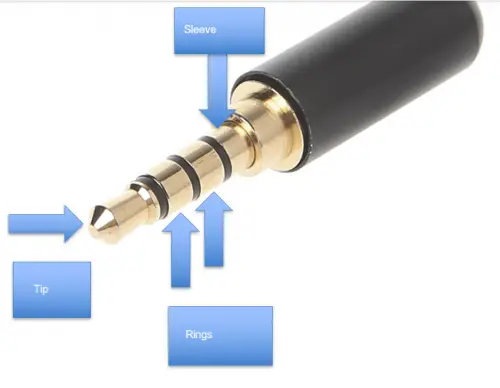Can You Plug a TS Cable Into a TRS Jack?
Plugging a TS cable into a TRS jack is possible. However, there may be a slight loss of signal, but it is nothing to worry about as far as any potential damage. TS cables carry an unbalanced signal (one channel), and a TRS has an unbalanced signal (two channels).
While it will feed a balanced signal into an unbalanced signal, it will not work to provide a balanced signal into an unbalanced signal (more information further defining the number of channels used and defining them as balanced or unbalanced will be further explained in this article).
As someone who has used multiple types of cables when playing guitar, I know that it can be confusing to know what cables connect when setting up your gear when you first start using them. I was initially overwhelmed when first going through all of these cables, what they connect to, and when to use each.
However, I soon realized there was no need to worry. Once you have a little experience with using these different types of cables, it is a simple and enjoyable process.
This article will go over all types of cables and jacks you can use and where and how they connect. We will also address if you can or can not plug a TRS cable into a TRRS jack; we will discuss and compare all of the cables in detail, define the different types of jacks, and discuss their functions, appearance, usage, their interchangeability, and which is better.
We will also answer two frequently asked questions. The first question we will address is, are guitar cables TS or TRS cables, and is a TS Jack Shorter Than a TRS Jack?
Also Read: Fender Vs PRS & Gibson: Are They Good & Worth It? (Electric)
Can You Plug a TRS Cable Into a TRRS Jack?
You can plug a TRS cable into a TRRS jack. The TRS cable is perfectly compatible with a TRRS socket. Please see the chart below for more details on each of these cables and jacks and how they are compatible with each other.
TS Vs TRS Vs TRRS
| TS | TRS | TRRS | |
| Abbreviation | Tip Sleeve | Tip Ring Sleeve | Tip Ring Ring Sleeve |
| Function | Compatible with Unbalanced Connections | Compatible with balanced connections | Carries unbalanced connections |
| Appearance | Two conductors | Three conductors | Four Conductors |
| Usage | Guitar cable | Stereo Headphones | Keyboards. Combines Microphone and Headphone Audio |
| Interchangeability | Can plug into TRS Jack. Can plug into TRRS with an adaptor. | Can plug into TRRS Jack. Can connect to TS, but with an unbalanced signal | Can plug into TRS with limited compatibility (will allow headphone but no microphone). Can be fixed with a splitter.
Can connect to TS with an adaptor. |
| Which Is Better | Good* | Better* | Best* |
Please see below under heading number 6 in this article: Which Is Better: TS Vs. TRS Vs. TRRS for a more detailed explanation as to how TS, TRS, and TRRS cables were determined to be ranked as good, better, and best depending upon their functionality and intended uses.
1. Abbreviation: TS Vs TRS Vs TRRS
The TS in TS cable stands for Tip Sleeve. The TRS cable stands for tip ring sleeve, and TRRS stands for tip ring ring sleeve. The T in each of these stands for tip and the S in each of these stands for sleeve.
2. Function: TS Vs. TRS Vs. TRRS
A TS cable carries a balanced signal and connects to unbalanced connections, like connecting a guitar to an amplifier. A TRS cable is used for a balanced signal, which helps to eliminate noise (are often used to produce a left and right audio signal). A TRRS carries a balanced signal between two devices and can be used to carry audio and compatible video.
An unbalanced signal or a mono signal (such as from an electric guitar to an amplifier) is carried by a TS cable. It uses one channel. A balanced or stereo signal (such as headphones or synthesizers) uses two channels.
3. Appearance: TS Vs. TRS Vs. TRRS
1. TS cables:
 Here is an example of a TS cable. The arrows in this picture point to the tip and the sleeve, thus the name TS. The arrow at the end of the cable is the tip; the other arrow points to the sleeve.
Here is an example of a TS cable. The arrows in this picture point to the tip and the sleeve, thus the name TS. The arrow at the end of the cable is the tip; the other arrow points to the sleeve.
2. TRS cables:
 Here is a picture of a TRS cable. The three arrows on the bottom of this graphic (from top to bottom) show this cable’s sleeve and ring. The arrow on top on the right points to the tip.
Here is a picture of a TRS cable. The three arrows on the bottom of this graphic (from top to bottom) show this cable’s sleeve and ring. The arrow on top on the right points to the tip.
3. TRRS cable:
 Here is a picture of a TRRS cable. TRRS stands for tip, ring, ring, sleeve. The arrows in the graphic below (from top to bottom) show the sleeve, the ring, and the tip.
Here is a picture of a TRRS cable. TRRS stands for tip, ring, ring, sleeve. The arrows in the graphic below (from top to bottom) show the sleeve, the ring, and the tip.
4. Usage: TS Vs TRS Vs TRRS
TS cables are typically used for electric guitars and basses when plugging into an amplifier. It is technically possible to use a TRS cable to plug a guitar into an amplifier. However, it would not work very well beyond a distance of twenty feet.
When referring to TS cables, TRS cables, and TRRS cables, they are often referred to as mono cables (one channel) or stereo cables (two channels). Another way to describe the connection of these cables is to say that a connection is either an unbalanced (one-way connection such as a TS cable) or a balanced connection (two channels such as a TRS cable or a TRRS cable).
Headphones will normally use TRS cables, along with audio mixers and synthesizers. They are also better when plugging equipment into multiple devices. TRS cables are typically referred to as balanced signals or stereo signals
A significant advantage of TRS cables is that they can take much of the guesswork out of which cable to use. Additionally, only one cable is needed for stereo use.
TRRS cables are best used for headphone/microphone combinations typically used in cell phones and video cameras. TRRS cables are generally used to connect audio and video or for headphones with a built-in microphone. The TRRS jacks are commonly used with smartphones and computers.
5. Interchangeability: TS Vs. TRS Vs. TRRS
TS cables and TRS cables are interchangeable with one another. However, there may be some issues with sound due to resistance if there is a distance of over twenty feet.
TRS cables can be used with a TRRS jack. If you are plugging a TRS cable into a TRRS jack on your cell phone, you will still be able to have a conversation on your cell phone. In instances where a TRS cable will not fit into a TRRS port, an adaptor can be used to resolve this problem.
A TS cable can plug into a TRRS port. There will, however, be a slight loss of signal. However, a TRRS cable can not plug into a TS port.
6. Which Is Better: TS Vs. TRS Vs. TRRS
In the chart above in this article, TS, TRS, and TRS were ranked as good, better, and best respectively based on the functionality of each of these jacks. TS was ranked as good based on its one-way or unbalanced channel usage. TRS was ranked as better based on its balanced and two-way channel usage, and TRRS was ranked as best based upon its two-way channel usage along with its multi-functionality use (i.e., TRRS allowing usage of both headphones and a microphone).
However, the ‘best’ option actually depends on what type of equipment you are using. A TS connection is the best choice for plugging a guitar into an amplifier. The best option for regular headphones would be a TRS connection, and the best option for a set of headphones with a built-in microphone would be a TRRS connection.
Also Read: Using Instrument Cables For Pedals: Are They Universal?
FAQs
Q: Are Guitar Cables TS or TRS?
Guitar cables are TS cables. They are used for an unbalanced or one-channel signal (from electric guitar to amplifier). Since the signal travels one way from the electric guitar or bass to the amplifier, guitar cables are TS cables.
Q: Is a TS Jack Shorter Than a TRS Jack?
Yes, a TS jack is shorter than a TRS jack. A TS Jack is typically 3.5mm, and a TRS jack generally is 6.35mm.
Conclusion
This article went over definitions of TS, TRS, and TRRS cables and explained why they are named as such. We also covered how each cable is used and for what type of equipment, along with comparing and contrasting these different cables.
This article also explained that a TS cable uses one channel or a mono connection, and a TRS cable uses a stereo or two-way channel. It also explained how TRRS cables allow for stereo or two-channel connections and allow for dual-use functions, such as a headset/microphone typically used with cell phones.
If this seems a bit overwhelming, please do not worry. Once you start regularly using TS, TRS, and TRRS jacks with their related equipment, you will find that it is quite a simple process.
The owner’s manual is also a great resource should there be any concerns about which cable to use with which piece of equipment.





